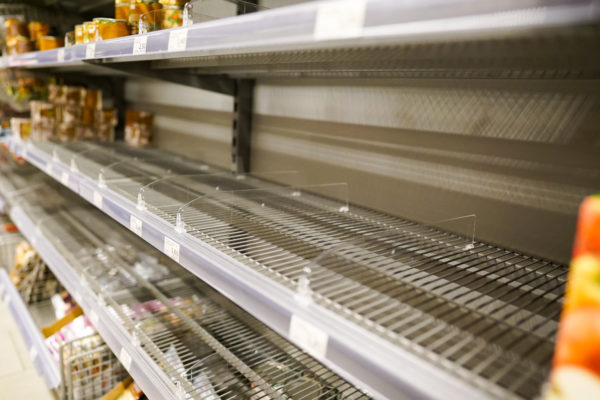
Seasonal food supply and demand is always a roll of the dice in many ways. Even in a typical year, producers of seasonal foods, like ice cream during the summer or turkey and pumpkins in the fall, have to try to gaze into their industrial “crystal ball” to predict what this year’s grocery stores and other retailers will need to keep their shelves adequately stocked.
But in 2020, getting ahead of the curve has grown exponentially more complicated by the COVID-19 pandemic, which has added one more thick layer of unpredictability on top of the usual pile of uncertainty. In these unprecedented times, people’s habits have completely changed, with many staying at home or working remotely. Thus, ordering particular kinds of foods or products in far greater quantities, sometimes with increased expectations of getting them delivered sooner than ever.
Some everyday items, ranging from hand sanitizer to toilet paper to non-perishables like canned vegetables or pasta, have been difficult to come by, off and on, for months.

As NPR described the “early days” of the health crisis back in March, “One end of the food supply chain has been completely upended as restaurants go dark and consumers prowl half-empty aisles of supermarkets. Food producers, though, are operating almost as normal — at least for now… Food distributors and wholesalers in the middle of that supply chain, meanwhile, are trying to perform logistical miracles, redirecting truckloads of food from shuttered businesses toward places where people now crave it — mainly grocery stores.”
So what’s the solution in the face of such a seemingly daunting era of constant flux? Let’s start here.
First, there’s a big difference between merely sitting back and tolerating unpredictability (sort of going with the flow and addressing things in a constant reactionary mode) versus managing it. Stepping up and actively getting ahead of the unpredictability entails not just ducking and weaving around whatever manner of chaos the winds of fortune blow your way, but getting proactive with your planning and scheduling and supply chain management.
You still have to work on formulating demand scenarios. While it’s crucial not to over-produce and stock up on too much inventory, you also have to situate yourself to where you can confidently (as much as humanly possible) secure on-shelf availability and fulfillment.
As a compelling post on the DELMIA Blog recently emphasized, companies must “provide the ability to change plans rapidly, and show how these changes affect the supply chain, so that manufacturers can act accordingly.”
In other words, the secret, as it turns out, is in your dexterity as a company and ability to pivot together, rather than as separate departments that aren’t communicating with one another.
Unfortunately — and I’ve seen this a thousand times — many organizations have huge disconnects between their planning, production, sales, logistics, and procurement processes. So, integrated business planning is another way to strategically plan on that alignment and optimize the supply chain from end to end.
Something we do at POWERS is to look at each supply chain holistically. Let me give an example. Let’s assume that a supply chain usually starts with the sales forecasting, goes through procurement, new products, planning, scheduling, manufacturing, and then into logistics.
Sometimes you may have a whole group of people at one firm that does nothing but purchasing. Then you’ll have another group that does operations, and another that does logistics and transportation.
Our tactical approach says that they don’t have to be individual people in their separate departments, all working in their own disconnected areas. Rather, it’s essential to work as one united entity.
For example, for purchasing, the internal customer is the plant because they’re buying all the raw materials and the supplies that go into the plan to fill and make the product. Their delivery of those supplies has to be on time. But what you typically find in many organizations is that purchasing doesn’t view production as their customer. They view them almost as a competing department because of siloes. They fight and argue – wasting valuable time in the process.
(For more on why it’s important in general to break down these kinds of silos in your organization, be sure to check out our post from last week about this very topic.)
Here’s another example: Let’s say I’m going to sell 100,000 cans of Starbucks Triple Shot this month. At the end of the month, I only sell 60,000 cans. Well, the metric for sales says you were 60% of your forecast. So what happened? On the flip side, production couldn’t make 100,000; they could only make 60. So then – is it production’s fault?
When you have those conflicting goals, it turns into a finger-pointing game, completely muddying the waters and preventing you from getting ahead of the challenge at hand.
Especially with demand planning, sometimes there may be up to eight or nine different workstreams. The trick is to tie those different workstreams together to ensure that the entire operation can function holistically. In other words: The inputs and outputs are all interdependent, and it’s vital that they get aligned.
In the end, there may be room to get excited about the possibilities in all of these challenges we’re grappling with today. As food historian Robyn Metcalfe said in an intriguing MIT Press-hosted roundtable just last month:
“What we’ve been discovering is that when a crisis arrives, all of the weak and fragile points in the food supply chain surface. And I think this is actually a good thing because we’re discovering all those areas that are ripe for innovation, and this accelerates that change,” she said, pointing to the dramatic reinvention that occurred during the Industrial Age and World War II.
“That sort of optimization is really being challenged now, and we’re going to be seeing more distributed networks – more personalized, more adaptable. I think those all those algorithms are about to change, and I think this crisis really forces that to the forefront,” Metcalfe concluded.
One more thing I’d like to wrap up with. A necessary step in getting proactive is to immediately address how your company culture impacts performance, efficiency, throughput, and, ultimately, your bottom-line. This is often precisely where POWERS clients can feel the most significant impact of our work together.
Unlike most consulting companies, we don’t apply a cookie-cutter approach to the businesses we work with, but customize our supply chain solutions and manufacturing productivity recommendations to whatever will be implementable and sustainable for the particular company we’re engaged with.
So, we’d love to hear from you: How are you steering your organization through this stretch of choppy supply and demand waters? What are you looking to address? Get in touch here or be sure to read our case studies or visit our YouTube channel for more.


